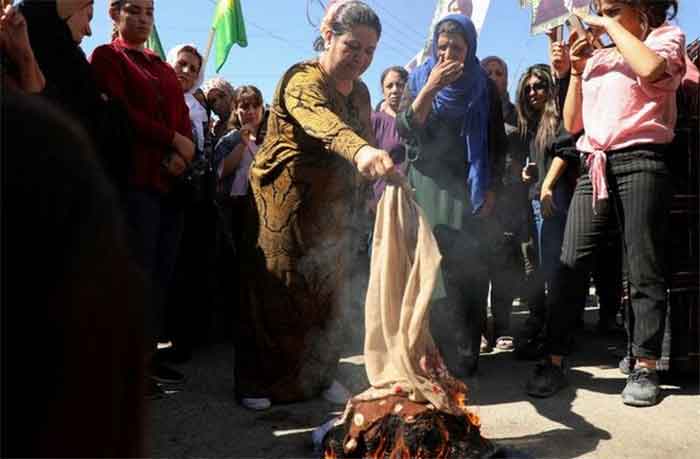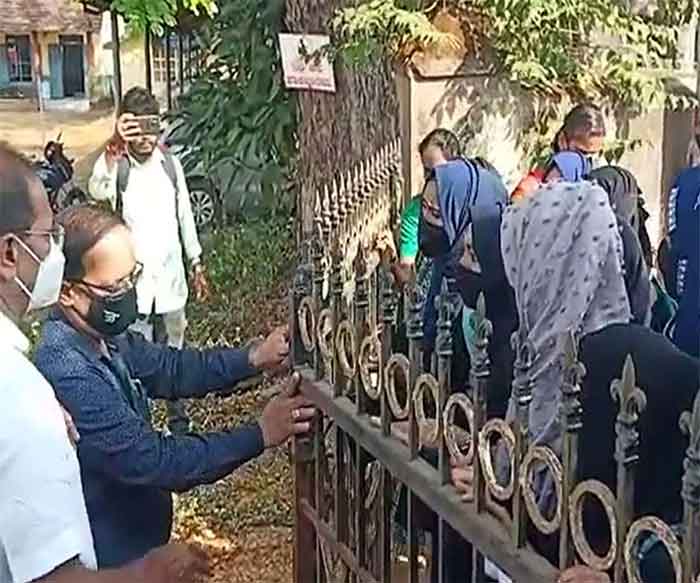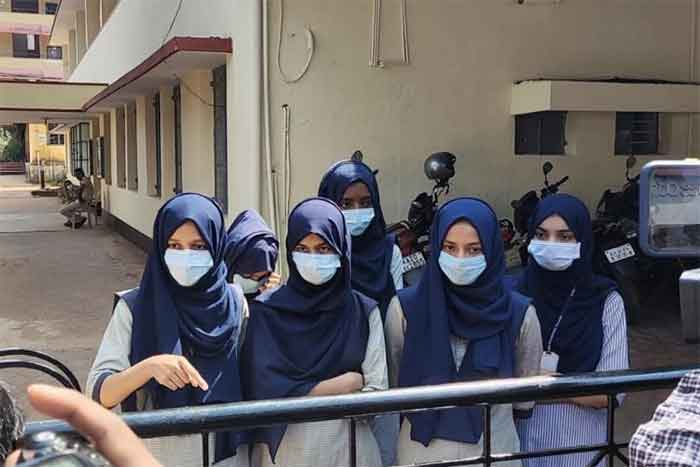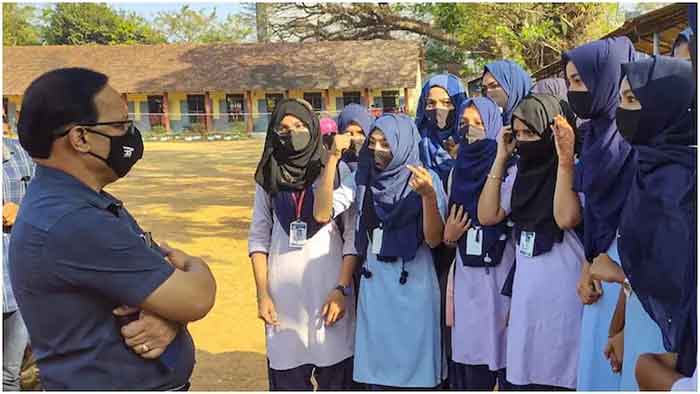
Just a few days back, an incident took place around the wearing of hijab by Muskan Khan. It has created huge controversies, leading to a deeply polarized situation in the realm of politics and society. This incident has created pan-Indian reactions and it has become an international issue. In this hijab row, political leaders and the so-called secular parties have also expressed their concern while addressing public rallies amid ongoing Uttar Pradesh (UP) assembly election. In this respect, progressive sections of women in general and Muslim girls (especially hijabi one who are studying in colleges and universities) in particular have come out on streets and as a result storm of protests took place in different part of country to express solidarity with Muskan. In doing so, they along with a section of left-liberals have appreciated Muskan’s bravery and courage for resisting against the saffron goons ( who were seen chanting the Jai Shri Ram) by raising the slogans of Alah-hu-Akbar (God is the great). On the one hand, Muslim scholars including secular minded social activists argued that hijab should not be banned in the public institutions because it violates right to freedom of religion and equality of citizen, enshrined in the Indian Constitution. On the other, it is argued that hijab and burqa should not be allowed in the public funded schools and colleges and wearing these regressive dresses is not essential teaching of Islam and mentioned in the Quran.
In addition to that Pasmanda ideologues see the entire hijab controversy from the lens of minority communalism and promoting the Ashrafisation (a process through the lower caste Muslim males and females both adopt the culture, life styles and habits of the upper caste Muslims often in the name of religion) within the Muslim community. They considered these issues are emotional and symbolic in nature rather than substantive (for instance, questions of bread & butter and problems of health and employment) witnessed by the ordinary Muslims in everyday life.
While defending Muskan, progressive sections have argued that wearing hijab is a fundamental right of individuals (enshrined in the Constitution of India) and it should not be banned in the public sphere. In other words, it is not a prudent decision to impose strict dress codes in colleges and elsewhere. While giving the short interview to the media, Muskan has also reiterated that wearing hijab is a personal choice and it should be respected and must be allowed in the colleges. Further responding to questions from the media, she hopes that the Court will protect her fundamental right to choice and will allow continuing secular education in the hijab. She also humbly urged that this incident should not be looked from the lens of communalism and the Hindus vs. Muslims binary; rather it is a matter of right to education and wearing hijab, according to her individual choice in democratic country like India. Till now, Karnataka High Court has not given a final verdict on hijab (whether it should be banned or allowed to wear in public spheres like colleges). However, the Court has said that college will be open and all students will be allowed to attend the classes as usual.
I am not going to discuss the legality of this issue, let the honorable Court decide and examine the constitutional validity on the issue of wearing hijab. I am also not much interested to talk about whether burka is akin to trishul (as a noted historian like Ramchandra Guha has drawn the analogy earlier between two) or regressive and oppressive identities. There are a lot of controversies involved on this issue and so far much has been written by the scholars. Rather, I will limit my focus to the larger public issues like right to education, structure and content of pedagogy and diversities in the public institutions. Secondly, I will also try to discuss what kind of dress code is prescribed in the Islamic text like in the Quran.
To be precise here, I have argued that diversities in the institutions of higher learning need to be restored and cherished for social and intellectual growth of students irrespective of caste, gender and religion persuasions. However, I do not entirely reject the need of the school uniform and common dress code yet, diversity in pedagogy, classroom and in colleges need to be taken seriously for the purpose of enhancing academic potential of students. In this respect, colleges and schools should have institutional autonomy to decide certain modicum of dress codes while keeping the larger ‘public decency’, ‘morality’ and cultural sensitivity of students in mind.
Most educationists have argued that diversities in the educational institutions and the classrooms are academically conducive for effective learning. In other words, diversities in dress codes, in pedagogy and in the classrooms need be cherished and promoted rather than it would be seen as a source of weakness and religious tensions, as the right-wing forces used to foreground. Academics minded scholars and educationists broadly agreed that uniformity in the dress codes and classroom education are not necessarily linked to effective learning of students. The best universities and colleges in India and abroad used to manage regional and social diversities in its pedagogy and in the classroom education. For instance, Delhi University, JNU, Hyderabad and Jamia to take a few names, are the best public universities in India and these higher learning institutions reflect social and cultural diversities in the campuses and in the classroom learning. However, it is sad commentary to note that in the current political scenario, there is decline of academic culture, and most of public institutions in India are infested with seeds of communalism and casteism. The suicide of radical young Ambedkarite student like Rohith Vemula in the Hyderabad Central University (HCU) earlier and most recently attacks on hijabi Muslim girl (Muskan khan) by saffron goons in the college can be cited as cases in point. Before coming to said issues, let me critically examine what arguments have been advanced by Islamic scholars in support of wearing hijab and burqa in the public sphere.
In this context, a large numbers of academic articles have been written by Islamic scholars on whether wearing of hijab, burqa and abaya are essential teachings and mandatory in Islam or not? In this regard, opinions are sharply divided among the Islamic scholars including the different schools and sects of Ulema. According to moderate and liberal scholars, wearing said dresses are not mandatory in Islam and it is considered as medievalist and patriarchal practice. A section of Muslim scholars (including Muslim women) have argued that Islamic text prescribes certain modicum of ‘modesty’ for both man and women rather than strict dress code, as said earlier, so that ‘public decency’ and ‘morality’ in the larger social sphere could be established.
Since I have limited understanding about Islamic theology, especially what kind of dress code is mentioned in the Quran? To enrich my understanding on the question of wearing hijab and burqa, I have visited the Darul Qaza office (located in Dildar Nagar, district Ghazipur, UP) and had a conversation with the Qazi saheb. He said that there are verses in the Quran which support the wearing of hijab ( it refers to Islamic concept of privacy and modesty). However, for him, it can be worn along with the school uniform. The Islam prohibits wearing those types of cloths which sexually attract men towards women and create ‘indecency’ in the larger society. More importantly, in Islam men and women (outside the family) should keep proper distant and restrain their eyes (nigahe ko niche kar le) towards each other so that decency and morality could be established in the public sphere, added by him.
For conservative and orthodox Ulema, women must wear the hijab, burqa and abaya (these three terms have been interpreted differently by Islamic scholars) before entering the public sphere including college or universities. For them, it is mandatory in Islam and mentioned in the Qaranic injunctions. Hence, there are varied interpretations that could be noticed among the different sects and schools of Islamic scholars, as far as dress code is concerned. so, it is a highly contested issue and hard to establish that there are strict prescribed dress codes mandatory and sanctioned by the Islamic theology. While looking at the ground realities of different Muslim countries (such as Soudi Arabia, Turkey, Iran and Indonesia, etc), it is difficult to demonstrate that there are uniform and monolithic Islamic dress codes followed by the Muslim women.
However, a larger public discourse created by Western media and hard core orientalists that Islam and Muslim community is highly oppressive and having anti-modern and narrow outlook, as far as women rights and their freedom is concerned. Toeing the lines of orientalists discourse, Hindu nationalist forces in India have also put forward that Islam and Muslim community is having backward looking and regressive views about women rights and their freedom. The fact is that in every caste and communities, women including young college going girls are the victim of ‘patriarchy’ and ‘illiberal culture’ and the Muslim community is not exceptional in this respect. However, for the Hindu right the Muslim women are victim of oppressive community ‘illiberal’ culture and religious orthodoxy. Therefore, women must be safeguarded from the Muslim males who perpetuate culture of violence and oppression under the pretext of protecting the community rights. The Hindu right used to cite the practice of instant triple talaq and the classic Shah Bano case in this respect. Most of liberals, feminists and Hindu nationalist have had taken almost similar positions especially on Shah Bano and criticized then the Rajive Gandhi government for succumbing to the pressure of the Muslim clerics and Muslim leaders.
However, in the case of Muskan, secular parties and progressive sections are now defending her position by saying that she has the right to choose the dress code, according to her own choice and it is not worthwhile to impose a ban on wearing of hijab in secular institutions like college and schools. A section of the scholars argued that burqa and hijab are enabling factors rather than creating hindrance to get modern and liberal education. Yet, radical feminists often argued that burqa and abaya including hijab are the patriarchal symbols imposed by the conservative clerics and community leaders to control women sexuality. And that is reason why the Muslim women are excluded from the mainstream society and compelled to live in the ghettos.
It has to be noted that the same religious and Muslim organizations that boycotted the apex Court verdict in case of shah Bano, are now defending the Muskan by saying that it is her religious freedom to wear hijab which is enshrined in the democratic Constitution of India. A section of Muslim organization (Jamiat Ulema-e- Hind) has announced five lacks prize for her bravery and having shown courage to resist against the saffron goons of the right-wing in the college campus. While giving a short interview to media, Muskan has underlined that this issue should be looked from perspective of the right to education, equality and individual choice to wear dress rather than the Hindus vs. Muslim binary for the sake of electoral gains.
However, it is also empirical fact that most of Muslim girls do not wear the hijab, burqa and abaya while attending the colleges and universities. My experience of teaching in the different universities and colleges for more than five years also indicates that it is empirically untenable to say that all Muslim girls wear the monolithic Islamic dress, as hinted earlier. Most of them are concerned about the relevant questions, for instance, how to get quality and affordable education amid secular environment irrespective of caste, class and religion.
I am not fully in favor of imposing ban on hijab in the educational institutions because it violets right to religious freedom, right to education and notion of diversity, as enshrined in the Constitution of India. However, for me ‘institutional autonomy’ of respective colleges and schools to decide a particular form of uniform (which respect values such as decency and morality towards each other in the public sphere) should be not entirely rejected. Let me end here by saying that controversy around hijab (in context of Karnataka and elsewhere) must be looked beyond the Hindus vs. Muslims binary and from purely religious prism. It needs to be foregrounded in the light of right to education, diversity, moral decency in the public institutions and including personnel choice to decide the dress, as Muskan has also hinted while responding to media houses.
Badre Alam Khan is a research scholar, Department of Political science, University of Delhi.















































